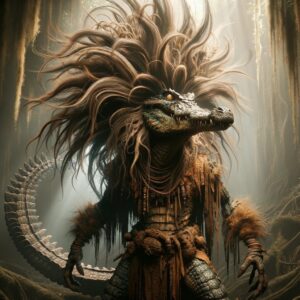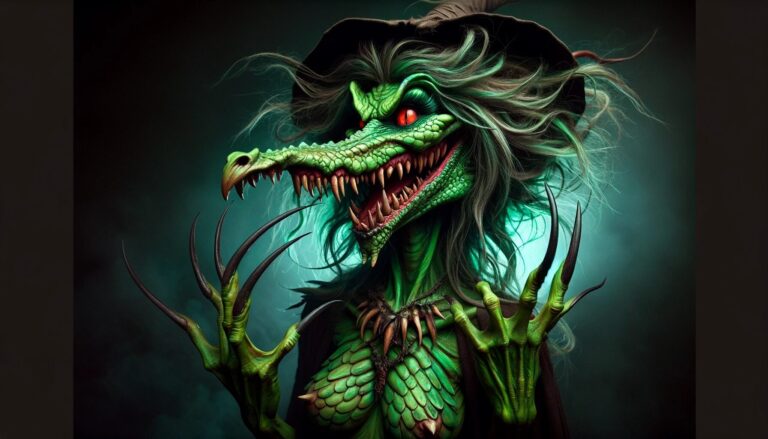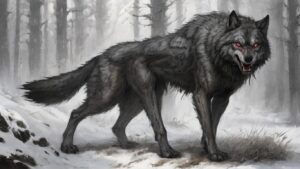Table of Contents
In the heart of Brazil, amidst the lush Amazon rainforest and the vibrant spirit of its people, lies a creature of legend known as the Cuca. This enigmatic and fearsome entity has deeply woven itself into the tapestry of Brazilian folklore, capturing the imagination of generations with its unique blend of terror and mystique.
Origins
The Cuca’s origins trace back to Brazil’s rich and diverse cultural heritage. Brazilian folklore prominently features this creature, and scholars believe it has roots that formed through a fusion of indigenous, African, and European influences. Its name, “Cuca,” is thought to have originated from the Kimbundu word “kuka,” signifying “darkness” or “spirit.” This etymology suggests a connection to African folklore, where spirits and supernatural entities play a prominent role.

The Cuca’s presence in Brazilian folklore most notably associates with the country’s indigenous and African populations, whose traditions and beliefs have contributed to the evolution of this mythical creature over the centuries. Although the Cuca’s exact origins remain shrouded in mystery, it has evolved into an iconic figure in Brazilian culture, embodying the fears and mysteries of the untamed wilderness.
Family Ties
In Brazilian folklore, the Cuca is often depicted as a sinister and malevolent entity, but it is not an isolated figure. Instead, it is part of a larger family of mythical creatures, each with its own unique traits and roles in folk narratives. Some of the most notable members of this family include the “Boitatá,” a fire-spitting serpent that guards the forests, and the “Curupira,” a mischievous forest spirit with backward-facing feet.
The Cuca, however, holds a distinct position within this supernatural family. Many often depict it as a wicked witch, an old hag with grotesque features, who preys on children and those who dare to venture too deep into the wilderness. Its familial connections reinforce the idea that the Cuca is a guardian or protector of the wild, serving as a warning to those who would disturb the natural order.
Appearance
The Cuca’s appearance is both unsettling and fascinating. As a shape-shifting entity, it can take on various forms to deceive and frighten its victims. However, its most common manifestation is that of a hideous old woman. In this form, people describe the Cuca as having wrinkled, greenish skin, long, unkempt hair, sharp claws, and a hooked nose. They say her eyes appear bloodshot, and her mouth is filled with jagged teeth, which adds to her nightmarish visage.

One of the Cuca’s most distinctive features is her ability to change her size at will. Additionally, she can transform into a diminutive creature to go unnoticed or grow to a gigantic size to strike fear into the hearts of those who encounter her. This shape-shifting ability only adds to her mystique and unpredictability, making her a truly formidable figure in Brazilian folklore.
In general, Cuca is often described as a monstrous and witch-like creature. Some common characteristics associated with Cuca include:
Abilities
The Cuca is not merely a frightful apparition; instead, it wields a range of supernatural abilities that establish it as a formidable force in Brazilian folklore. Among its numerous powers, the Cuca possesses the ability to cast spells and curses. These curses are often directed at individuals who have offended it or ventured too close to its domain. Consequently, these curses have the potential to bring misfortune, illness, or even death to their unfortunate victims.
Furthermore, the Cuca is reputed to exercise control over the elements of nature, particularly water. Believers attribute its habitat to areas near rivers, swamps, and other bodies of water, enabling it to manipulate currents, summon storms, and create whirlpools to ensnare its prey. This connection to water introduces an aquatic dimension to the Cuca’s mythology, further enhancing its multifaceted nature.
Another eerie ability attributed to the Cuca is its power to enter the dreams of children and lure them into the depths of the forest. Once a child falls under its spell, the Cuca can transport them to a hidden lair, where they are at the mercy of its sinister intentions. This ability to infiltrate dreams and lead children astray reinforces the Cuca’s reputation as a child-snatching fiend.
Symbols
The Cuca deeply ingrains itself in Brazilian culture, and people often invoke its presence through various symbols and representations. Moreover, an old hag with sharp claws, a hooked nose, and a menacing grin is one of the most common symbols associated with the Cuca. This image captures the Cuca’s malevolence and frequently appears in illustrations and artistic interpretations.

Water-related symbols, such as swirling waves, whirlpools, and aquatic plants, also link to the Cuca because of its connection to bodies of water. These symbols emphasize the creature’s power over the aquatic realm and its ability to manipulate water for its advantage.
Some depictions portray the Cuca alongside other mythical creatures from Brazilian folklore, creating a visual narrative that showcases the interconnectedness of these supernatural beings. This symbolizes the intricate web of folklore and the enduring presence of these legends in Brazilian society.
Myths and Stories
Countless myths and stories have featured the Cuca as a central character, passed down through generations in Brazil. These narratives often serve as cautionary tales, warning children about the dangers of wandering too far from home or disobeying their parents.
One popular myth recounts the story of a disobedient child who ventures into the forest, despite warnings from their parents. In the depths of the wilderness, they encounter the Cuca, who lures them away with promises of sweets and toys. The child is never seen again, serving as a stark reminder of the consequences of disobedience.
Another tale tells of a clever child who outwits the Cuca by playing a game of riddles. The Cuca, frustrated by the child’s wit, eventually lets them go unharmed. This story conveys the importance of wit and intelligence in facing life’s challenges, even in the face of malevolent forces.
In addition to cautionary tales, the Cuca also appears in Brazilian literature, music, and popular culture. Its presence in these mediums further solidifies its status as a cultural icon, ensuring that the legend of the Cuca continues to captivate and intrigue people of all ages.
Similarities
Several mythical creatures from various cultures share similar abilities or appearances with the Cuca. Here are a few:
Baba Yaga (Russian folklore): Similar to Cuca, people often depict Baba Yaga as a wicked old witch with supernatural abilities, including shape-shifting and casting spells.
La Llorona (Latin American folklore) : The Weeping Woman. Like Cuca, she shares an association with water and roams near bodies of water, mourning the loss of her children.
Kappa (Japanese folklore): Kappas are water creatures with a humanoid appearance, often depicted with webbed hands and the ability to manipulate water.
The Kraken (Norse and Scandinavian folklore):The Kraken, a massive sea monster known for creating whirlpools and wreaking havoc in the ocean, is not humanoid, like Cuca’s power over water.
The Wicked Witch of the West (Wizard of Oz): In popular culture, this iconic witch shares some similarities with the Cuca, including her greenish appearance and malevolent nature.




